Freda Lightfoot's Blog, page 15
November 28, 2012
Dora Jordan - a woman of strength and a warm heart
Despite seeing herself as Irish, the famous actress, Mrs Jordan, was in fact born in London near Covent Garden in 1761, no doubt where her stage-struck parents were seeking work at the time, and where she was baptized Dorothy Bland. Her sisters called her Dolly. She preferred Dora and adopted that as her stage name.
Turning to acting out of necessity rather than choice, her father having
Turning to acting out of necessity rather than choice, her father having

Published on November 28, 2012 23:00
November 6, 2012
The Next Big Thing
Frances Brody http://www.frances-brody.com/blog/, author of the Kate Shackleton murder mysteries, has invited me to take part in a blog event entitled THE NEXT BIG THING - a series of questions and answers about what’s happening next in my writing life.
What is the title of your book?
My next book, published at the end of November, is THE DUCHESS OF DRURY LANE.
What genre does your book fall
What is the title of your book?
My next book, published at the end of November, is THE DUCHESS OF DRURY LANE.
What genre does your book fall

Published on November 06, 2012 00:30
November 2, 2012
Raising your Profile
For any writer, raising your profile is important. Having just returned from a fantastic Ninc conference in New York, I thought I'd list some of the tips I picked up.
Social networking:
You can’t do everything, so choose what suits you and do it well.
Try to find out where your readers are.
How are they finding you?
Fewer than ever find books in stores now. Sad but true.
Facebook and
Social networking:
You can’t do everything, so choose what suits you and do it well.
Try to find out where your readers are.
How are they finding you?
Fewer than ever find books in stores now. Sad but true.
Facebook and

Published on November 02, 2012 07:16
October 14, 2012
Leeds-Liverpool Canal
Pictures taken on a lovely walk along the canal towpath on what is known as the Lydiate Loop. The entire walk is about 6 or 7 miles, and most enjoyable.


Published on October 14, 2012 09:03
October 7, 2012
Visit to The Hardman's House in Liverpool
Edward Chambré Hardman was born in 1898 in Dublin. He became a talented photographer, often travelling abroad to France to take photographs. He and his wife Margaret lived in a tall Georgian terraced house in Rodney Street, Liverpool. Most of the house was used for their business. A waiting room and changing room on the ground floor, the studio on the first floor where Mr Hardman would 

Published on October 07, 2012 08:57
September 21, 2012
The Secret Purpose of Masques at the French Court.
Catherine de Medici is reputed to have imported the fashion of masques to France from her native Italy, along with works by the Italian dancing masters. Her festivals and tournaments were famously lavish and spectacular entertainments. She spared no expense and employed the finest artists, musicians, choreographers and skilled craftsmen to create the necessary dramas and effects. A highly 

Published on September 21, 2012 00:30
September 10, 2012
Norwegian Fjord Cruise
Voyages of Discovery was our ship. Here she is in port.
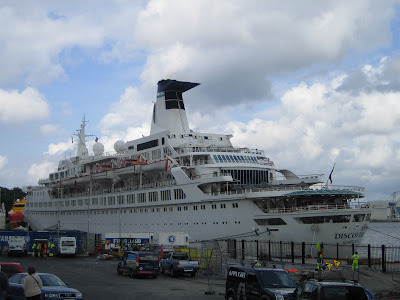
We spent 10 days at the end of August on a magical cruise around the fjords of Norway.
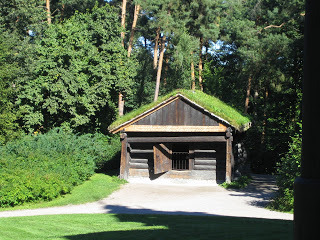
Starting from Harwich, our first stop was
Oslo where we visited a World War II museum then to an open air museum
with houses dating from the fifteenth century and earlier. Note the
grass on the roofs.
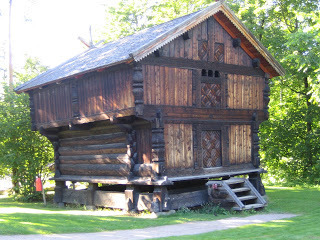
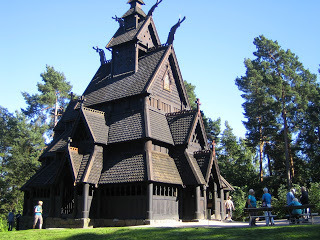
And an amazing church.
These buildings were painstakingly dismantled from their original sites and reconstructed here in the museum.
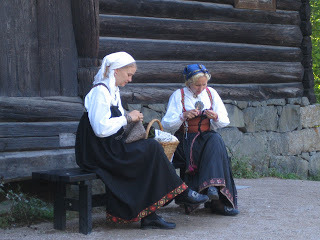
Two of the friendly stewards keeping busy in a traditional way.
We then moved on to the Viking Museum to see ships that date back to around 820-1000 AD. There was a great deal of detail to explore about the archaeological digs which had recovered skeletons, as well as ships. Fascinating for a history freak like me.
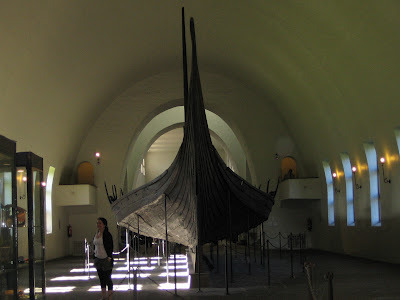
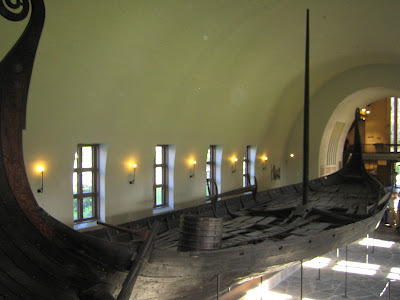
Kristiansand was the next port of call with its delightful timber cottages. This is Hollen, a former fishing village, now a popular residential area.
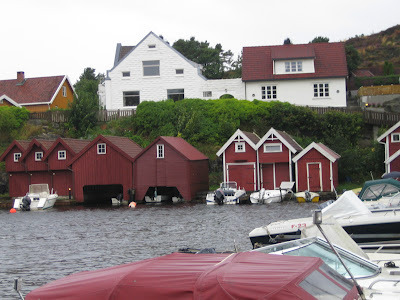
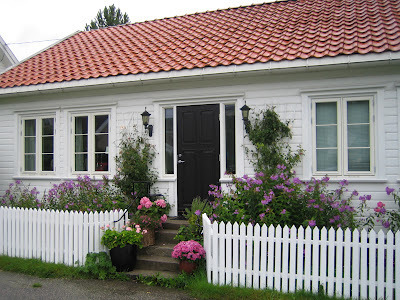
Lysefjord is awe-inspiring, although as you can see the same could not be said for the weather. It felt almost as if we had slipped back to ancient times.

And here is the spectacular Pulpit's Rock, as viewed from our small river boat.

The goats came down to the boat to be fed.


Alesund, a delightful little town with art deco style buildings as it was rebuilt in 1904 following an earthquake. The time travel museum is worth a visit, and there are plenty of good shops.
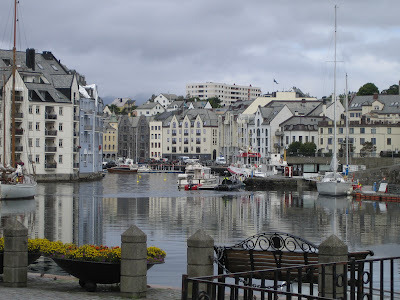
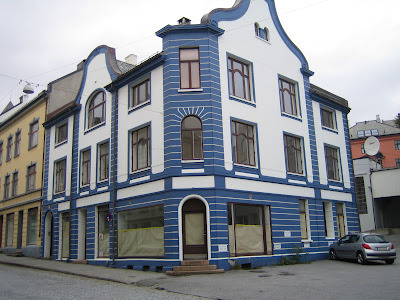
Flam is a small village in the Aurlansfjord, largely dependent on the salmon and trout fishing. But from here you can take the railway up into the mountains for stunning scenery and an astonishing fete of engineering.



A kindergarten group enjoying a damp day on the railway.
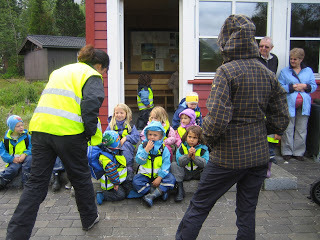
Back on board we sailed up the Naeroyfjord.
This is Gudvangen. Beautiful and so remote.
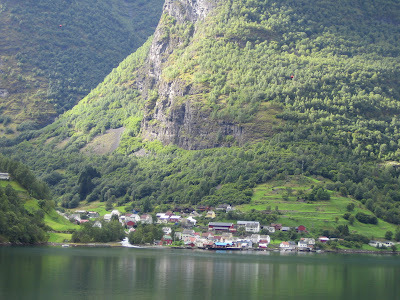
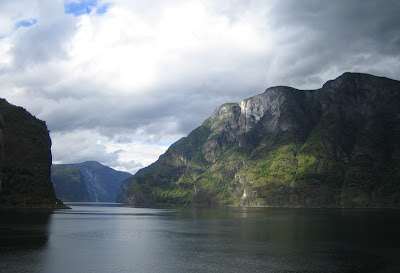

Lastly we visited Bergen, which is a bustling, charming seafront town with an ancient Hanseatic wharf with lots of local craft shops to explore.
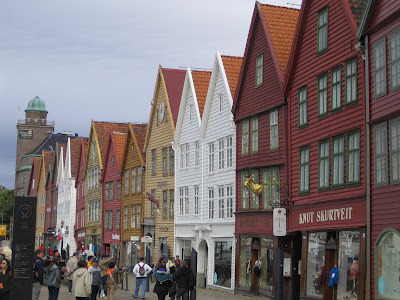
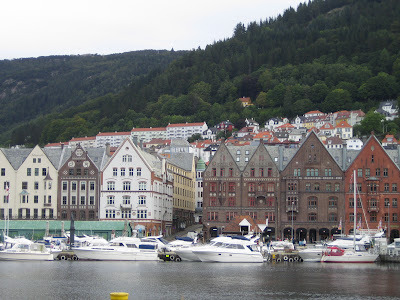

Published on September 10, 2012 08:51
September 7, 2012
Renaissance Women in 16C France
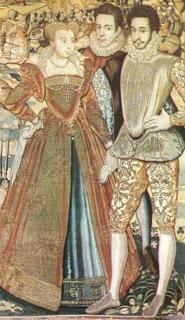
‘Frenchwomen,’ said a critic, ‘are very devout in seeming, but in point of fact they are very light and very free. Every one of them, even if she be a courtesan, wishes to be treated as an honest woman, and there is no lady of bad fame who has not some objection to make to the morals of her neighbour.’
Nuns, apparently, were worse. But then many were quite secular in their habits, certainly Henry IV of France enjoyed affairs with several, including Marie de Beauvilliers, abbess of Montmartre. He did like to spread his favours. But then women often chose to enter a nunnery, considering this a better option than marrying a man they didn’t care for. And who could blame them since women often had little control over their choice of husband.
Many Renaissance women, however, were independent and well educated.
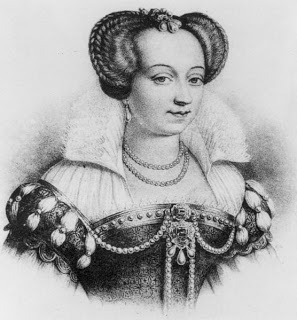
Marguerite de Valois was proficient in French, Italian, Latin, Greek, music and mathematics as well as her devotions. But it wasn’t only royalty and the aristocracy who believed in education. The bourgeoisie were also great advocates of such refinements. It was considered that an educated woman was better able to maintain her family’s health, raise her children well, make her husband content and keep a household in order. The reformation also encouraged education for girls so that they were able to read the scriptures for themselves and be spiritually closer to God.
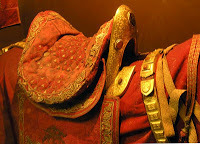
Daughters, however, were kept very much on a tight rein. They
were expected to walk behind their mothers, and were rigorously attended and chaperoned at all times. When travelling they were expected to ride en croupe (pillion) behind a servant, observing the proprieties by clinging only to the pommel and not by putting their arms about the servant’s waist. Clearly that would have been beyond the pale. Once having gained some skills she may be allowed to ride side-saddle, which required hooking one leg around the horn of the saddle.
Nor were young ladies allowed to drink, although their mothers might add a splash of Burgundy to give their water a little colour and flavour. ‘But their deportment,’ said an observer, ‘conveyed rather their good taste than their truth.’
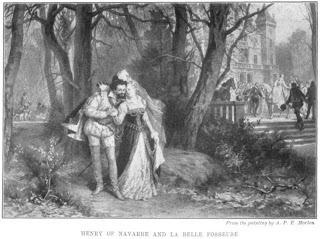
Men grumbled, of course, at women’s independence, just as they do now. Nothing changes! They complained that their wives talked too much, stopping to gossip with passers-by in the street. They objected about their readiness to go alone to church or market, often being out and about for hours at a time, and ‘their husbands never daring to ask where they were.’ So a passion for women’s rights obviously simmered beneath the surface. One amusing rule I found for widows, was that they were obliged to wear a high necked dress, long cloak and a veil, and the authorities felt obliged to pass a law restricting the style as widows’ veils had become ‘dangerously attractive.’ You can’t keep a bad girl down.
Henriette d’Entragues was clearly of an independent mind, being highly ambitious and manipulative, with her sights set upon wearing a crown. But while Henry IV might have been sufficiently besotted to agree to anything to get her into his bed, his political advisers and ministers were another matter altogether. A King was not expected to marry his mistress. Could Henriette raise her status and break the rules of etiquette? She was very determined to try.
The Queen and the Courtesan, published 29 June, can be found as a paperback or ebook here:
Amazon
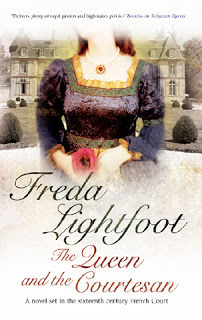
Most of my titles are now available as ebooks on Amazon, Kobo, Smashwords etc. Links to them can be found on my website:
http://www.fredalightfoot.co.uk

Published on September 07, 2012 00:30
September 4, 2012
Fire in Spain!
We returned from holiday to discover a whole tranch of emails with news of fire in Spain. Fortunately one from b-i-l had the subject - Open this first - which we did, so were quickly reassured all was well and our Spanish house was safe.

The fire pretty well surrounded the village, but the bomberos did a splendid job with their helicopters and water planes, and no property sustained any serious damage. I've seen them do this in the past, they scoop up water from swimming pools, or from the sea, and without losing any power despite the added weight, they scatter it over the fire. Most impressive. They apparently drenched one of our neighbours too, although she didn't mind as they saved her house and garage. Some terraces were gutted, trees and gardens destroyed in an instant, and there was a great deal of smoke damage. More importantly, no lives were lost. When friends saw the fire coming they hurriedly packed bags and escaped, watching the flames circle the village and their homes from a safe distance, and seeing it disappear under a blanket of black smoke.
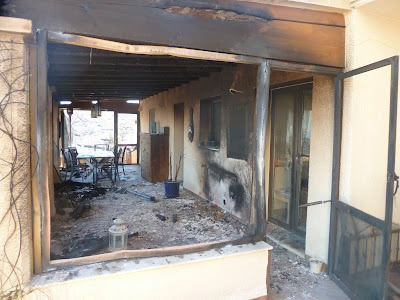
These friends lost this terrace area, and our hearts go out to them. They say they won't be able to return to their home for a month because of the smoke damage inside.
The village was evacuated with dozens of coaches bussing those people out who did not have their own transport. The army, the Guardia, the Medio Ambiente and the Policia Local were all out in force working with the bomberos. The villagers were accommodated in hostals and town halls in nearby towns. It was a most efficient operation apparently, yet we remained blithely
unaware of this terrifying crisis as we enjoyed our cruise in the
Norwegian Fjords.
Here is the aftermath, blackened countryside all around. Our house is in a dip to the far right and fortunately not in the direct path of the fire, but it was but a breath away.


And how did it start? Well, it wasn't an act of God or nature, it was two idiots a couple of miles below the village who decided to do a spot of welding out in the open in temperatures of over 42 degrees. They are now in jail facing a huge bill of hundreds of thousands of euros in compensation.



The fire pretty well surrounded the village, but the bomberos did a splendid job with their helicopters and water planes, and no property sustained any serious damage. I've seen them do this in the past, they scoop up water from swimming pools, or from the sea, and without losing any power despite the added weight, they scatter it over the fire. Most impressive. They apparently drenched one of our neighbours too, although she didn't mind as they saved her house and garage. Some terraces were gutted, trees and gardens destroyed in an instant, and there was a great deal of smoke damage. More importantly, no lives were lost. When friends saw the fire coming they hurriedly packed bags and escaped, watching the flames circle the village and their homes from a safe distance, and seeing it disappear under a blanket of black smoke.

These friends lost this terrace area, and our hearts go out to them. They say they won't be able to return to their home for a month because of the smoke damage inside.
The village was evacuated with dozens of coaches bussing those people out who did not have their own transport. The army, the Guardia, the Medio Ambiente and the Policia Local were all out in force working with the bomberos. The villagers were accommodated in hostals and town halls in nearby towns. It was a most efficient operation apparently, yet we remained blithely
unaware of this terrifying crisis as we enjoyed our cruise in the
Norwegian Fjords.
Here is the aftermath, blackened countryside all around. Our house is in a dip to the far right and fortunately not in the direct path of the fire, but it was but a breath away.


And how did it start? Well, it wasn't an act of God or nature, it was two idiots a couple of miles below the village who decided to do a spot of welding out in the open in temperatures of over 42 degrees. They are now in jail facing a huge bill of hundreds of thousands of euros in compensation.

Published on September 04, 2012 07:33
August 24, 2012
Renaissance Weddings
‘The marriage arrangements have been successfully concluded.’ Ferdinando I, Grand Duke of Tuscany, beamed exultantly upon his niece, Marie de Medici. ‘In return I have agreed to release France from its indebtedness, the balance to be given in cash to a total sum of 600,000 crowns, which will represent your dowry.
Poor Marie. She was but a pawn in a game of politics.Marriage was rarely about love, but generally about money, land, estates, politics or power. Henry IV knew that France was in a parlous state, and much as he might wish to marry Henriette d’Entragues, his mistress, he must do his duty and marry an Italian Princess. Henriette dubbed her ‘The fat banker.’
Here she is as she appeared when arriving at Marseilles.
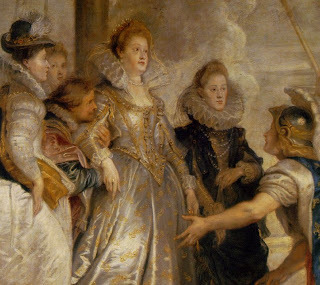
To any marriage, the bride was expected to bring a dowry and a bridal trousseau.A daughter of the bourgeoisie might have brought linen, household goods, pewter plates, candlesticks, or even livestock. Marie brought jewels in addition to the vast sum paid by her uncle. But then she was a royal princess.This property was not hers to keep. On marriage it passed into the possession of her husband, as did she herself. If the marriage was annulled, as in the case of Marguerite de Valois, Henry’s first wife, then the bridal dowry would be returned, and sometimes too her dower estates. Except in Margot’s case she had to fight for the return of hers, and until the finances were agreed between herself and Henry, she refused to grant him the divorce he craved to marry Marie de Medici.
Royal brides often went through a proxy marriage first, as the intended husband was more than likely thousands of miles away, and she would not be allowed to embark on such a journey without that security. It was as binding as the true marriage ceremony, which followed when the bride and groom actually met. This is a later picture of Henry IV of France. No doubt he was more handsome in his youth.
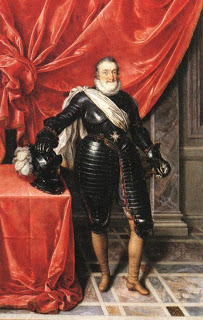
For Marie’s proxy wedding, The Duc de Bellegarde, Grand Equerry of France, together with an entourage of forty nobles, reached Livorno on the 20th of September. Seven days later he entered Florence, and on 6 October 1600, the proxy wedding took place, the Grand Duke Ferdinando himself standing in for the absent husband. His Eminence made his entry on horseback beneath a canopy held high by eight young Florentine nobles, preceded by all the ecclesiastical and secular bodies, sixteen prelates, and fifty gentlemen bearing halberds.
Afterwards would come the celebrations with a ball and banquet, hunting-parties, jousts, races, tilting at the ring and other sports, while the nights would be filled with dancing, plays, masques and ballets. The bride would then set out to go to her husband, a journey across land and sea which might take weeks or even months. And often within a day of meeting, the ceremony proper would take place. Here is a picture of Marie's wedding.
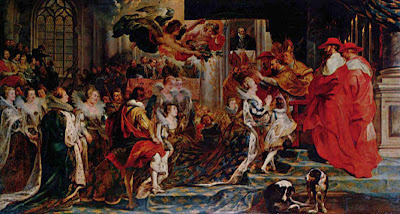
Dressed in a gown of crimson, blue and gold, fashioned in the Italian style and glittering with jewels that represented a goodly portion of her dowry, she looked a queen in every respect, even one not yet crowned. About her neck she wore the valuable pearl necklace, given to her by the King, but the most magnificent ornament consisted of an octagonal diamond brooch. Worn on her stomacher it was framed by several smaller stones, each enclosing a portrait in enamel of one of the princes of her house, beneath which hung three large teardrop pearls. It became known as the Queen’s Brilliant.
And so the bride would be wedded and bedded to a perfect stranger, stripped of her possessions, her ladies-in-waiting often returned whence they came, and a whole new way of life in a foreign land would begin. Within days of Marie de Medici’s marriage, Henry returned to Henriette, a pretty little madam, but a very ambitious lady who was to cause Marie no end of problems.

The Queen and the Courtesan can be found as a paperback or ebook here:
Amazon

Poor Marie. She was but a pawn in a game of politics.Marriage was rarely about love, but generally about money, land, estates, politics or power. Henry IV knew that France was in a parlous state, and much as he might wish to marry Henriette d’Entragues, his mistress, he must do his duty and marry an Italian Princess. Henriette dubbed her ‘The fat banker.’
Here she is as she appeared when arriving at Marseilles.

To any marriage, the bride was expected to bring a dowry and a bridal trousseau.A daughter of the bourgeoisie might have brought linen, household goods, pewter plates, candlesticks, or even livestock. Marie brought jewels in addition to the vast sum paid by her uncle. But then she was a royal princess.This property was not hers to keep. On marriage it passed into the possession of her husband, as did she herself. If the marriage was annulled, as in the case of Marguerite de Valois, Henry’s first wife, then the bridal dowry would be returned, and sometimes too her dower estates. Except in Margot’s case she had to fight for the return of hers, and until the finances were agreed between herself and Henry, she refused to grant him the divorce he craved to marry Marie de Medici.
Royal brides often went through a proxy marriage first, as the intended husband was more than likely thousands of miles away, and she would not be allowed to embark on such a journey without that security. It was as binding as the true marriage ceremony, which followed when the bride and groom actually met. This is a later picture of Henry IV of France. No doubt he was more handsome in his youth.

For Marie’s proxy wedding, The Duc de Bellegarde, Grand Equerry of France, together with an entourage of forty nobles, reached Livorno on the 20th of September. Seven days later he entered Florence, and on 6 October 1600, the proxy wedding took place, the Grand Duke Ferdinando himself standing in for the absent husband. His Eminence made his entry on horseback beneath a canopy held high by eight young Florentine nobles, preceded by all the ecclesiastical and secular bodies, sixteen prelates, and fifty gentlemen bearing halberds.
Afterwards would come the celebrations with a ball and banquet, hunting-parties, jousts, races, tilting at the ring and other sports, while the nights would be filled with dancing, plays, masques and ballets. The bride would then set out to go to her husband, a journey across land and sea which might take weeks or even months. And often within a day of meeting, the ceremony proper would take place. Here is a picture of Marie's wedding.

Dressed in a gown of crimson, blue and gold, fashioned in the Italian style and glittering with jewels that represented a goodly portion of her dowry, she looked a queen in every respect, even one not yet crowned. About her neck she wore the valuable pearl necklace, given to her by the King, but the most magnificent ornament consisted of an octagonal diamond brooch. Worn on her stomacher it was framed by several smaller stones, each enclosing a portrait in enamel of one of the princes of her house, beneath which hung three large teardrop pearls. It became known as the Queen’s Brilliant.
And so the bride would be wedded and bedded to a perfect stranger, stripped of her possessions, her ladies-in-waiting often returned whence they came, and a whole new way of life in a foreign land would begin. Within days of Marie de Medici’s marriage, Henry returned to Henriette, a pretty little madam, but a very ambitious lady who was to cause Marie no end of problems.

The Queen and the Courtesan can be found as a paperback or ebook here:
Amazon

Published on August 24, 2012 00:30
Freda Lightfoot's Blog
- Freda Lightfoot's profile
- 210 followers
Freda Lightfoot isn't a Goodreads Author
(yet),
but they
do have a blog,
so here are some recent posts imported from
their feed.



